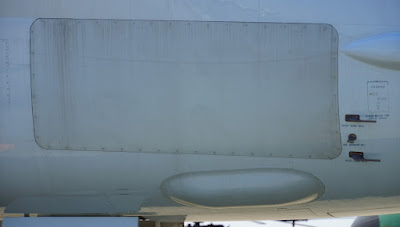The nose of the Japanese P-1 maritime patrol aircraft houses the main Toshiba/TRDI HPS-106 active electronically scanned array (AESA) search radar. Source: j-hangarspace.jp
Photos and descriptions (above and below) are reproduced on a Thai Military and Asia Region article https://thaimilitaryandasianregion.wordpress.com/2015/10/15/japan-kawasaki-p-1-patrol-aircraft/
The HPS-106 side-looking radar array is housed beneath this panel just below the cockpit. Source http://daisetsuzan.blogspot.com/2016/01/kawasaki-p-1-maritime-patrol-aircraft.html
---
PETE COMMENT
Desmond Ball and Richard Tanter's, The Tools of Owatatsumi: Japan’s ocean surveillance and coastal defence capabilities, ANU Press, 2015 Chapter 10 Airborne Ocean Surveillance especially page 82
provides context on Japanese maritime search developments. This includes the HPS-106 search radar, which, when mounted on Japanese P-1 maritime patrol aircraft (MPAs) can search for surfaced
submarines (maybe periscopes?) and surface ships, as well as find lost boats. Presumably the US
built Poseidon P-8 MPA has radars of similar capabilities.
provides context on Japanese maritime search developments. This includes the HPS-106 search radar, which, when mounted on Japanese P-1 maritime patrol aircraft (MPAs) can search for surfaced
submarines (maybe periscopes?) and surface ships, as well as find lost boats. Presumably the US
built Poseidon P-8 MPA has radars of similar capabilities.
ARTICLE
wispywood2344 on his/her Japanese website, which translates as Remembrance of Chiba Silver
Pigeon, has written a fine article,dated April 19, 2018, on the number of antennas and
coverage of the HPS-106 search radar used on Japanese P-1 MPAs. Here is part of the article:
"Currently, the Japanese Navy is proceeding with the deployment of the Kawasaki P-1
"Currently, the Japanese Navy is proceeding with the deployment of the Kawasaki P-1
MPA as a successor to the P-3C Orion patrol aircraft. The P-1 was developed domestically at the
The "HPS-106" search radar was developed as a multifunctional radar system to be mounted on the
P-1 patrol aircraft I was told.
This HPS-106 has multiple active electronically scanned array (AESA) antennas as antennas for
transmitting and receiving radar waves. By sending the waves in separate and precise directions
vessels can be located in a patrol area.
Regarding the number of equipments and coverage of the AESA antenna:
• A total of 4 AESA antennas are installed in each of the front, rear, left and right sides of the
fuselage, and the entire circumference of 360 degrees in front, rear, right and left of the
fuselage can be scanned
• There are blind spots behind the aircraft because the AESA antenna is equipped only with a total of three sides and the rear of the aircraft is unable to be scanned
There are various ways to find more information, including the Internet:
(In an English-speaking website, it is common to see articles with "Wide area scan with
4 AESA equipments" as Wikipedia English version of P-1, but there are no articles with
citations listed. The sources are unknown.)
Since the HPS-106 is an equipment of the Japanese Defense Force, in order to investigate
further, it is necessary to read official publications of the Ministry of Defense...[Several Tables with
descriptions in Japanese follow]
WISPYWOOD2344's WHOLE ARTICLE (IN JAPANESE) IS HERE.


















